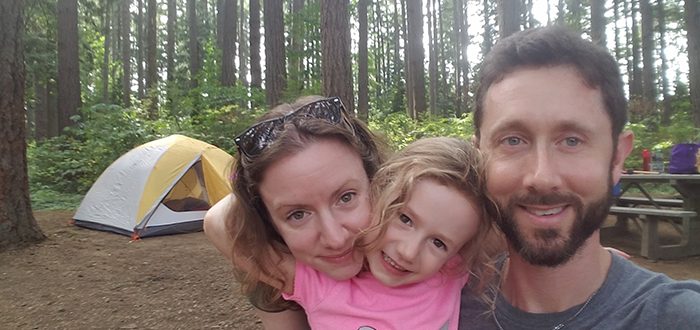Profile: From Fabrication Cleanrooms to a PhD
(Photo of Sarah Siegel with her daughter Elizabeth and husband Michael courtesy of Sarah Siegel)
The path to her PhD in Epidemiology has been a long and circuitous for Sarah Siegel, one that has taken her from Hewlett Packard’s wafer fabrication cleanrooms to Seattle’s Children’s Hospital to the OHSU-PSU School of Public Health.
Originally from Massachusetts, Sarah’s undergraduate degree from Cornell University was in Materials Science & Engineering, with a minor in Biomedical Engineering. In addition to Hewlett-Packard, her training led her to work at Kimberly-Clark in process engineering, where she worked on the VIVA paper towel line with a focus on quality assurance and quality control.
It was while she was working at HP, though, that she spent a lot of time with fabrication operators. “I have spent a few years in a ‘bunny suit’ working in wafer fabrication clean rooms,” she notes. She saw how the fabrication operators worked 12-hour shifts, all the time standing on their feet, and doing repetitive moments day in and day out. “As an engineer, I had the luxury of working a traditional 8-5 with most of my time spent behind a desk that was ergonomically fit for me,” Sarah recalls. “To better get to know all the operators on all the shifts, I would come in on off-hours and work besides them in the fab. It was shocking how poor the majority of operators’ health was, with the majority of their physical issues stemming from the type of work being done.”
From those conversations, she developed a proposal to move a piece of equipment 20 feet in the fabrication room, demonstrating that the amount of time and worker’s compensation costs that would be saved over the long-term would offset the $1 million price tag. “This move was motivated by the operators, as they had to run between machines to ensure there were no issues with the overall process. Moving this piece of equipment allowed them to have a space to sit and see all the equipment, as well as reducing the overall wear-and-tear on their bodies,” she adds.
It was a transformational moment for her. “Affecting evidence-based change that helped others was hugely empowering.”
In search of a more meaningful career, one where she could make the type of impact on people’s health like she had at HP, she started volunteering at Seattle Children’s Hospital while taking an introduction to epidemiology class at the University of Washington. She was hooked. It was then that she first applied to OHSU for her MPH, after which she stayed on to work at OHSU for a few years before entering the PhD program.
The OHSU-PSU School of Public Health was a perfect fit for her family needs. “Returning to school in my 30’s prompted me to think about a completely different set of priorities then I did when I went to Cornell University for my undergraduate education. Also, the knowledge of entering the PhD program at SPH when it was first started was very exciting, as I wanted to be part of something new and ground-breaking.”
Sarah’s area of expertise is infectious diseases, specifically psoriasis. While psoriasis itself is not an infectious disease in the sense of being contagious, individuals who suffer from immune-modulated diseases, such as psoriasis, are at risk for developing infections. Many of the newer therapies approved by the FDA in the past decade (called “biologics”) have focused on disrupting certain pathways of an individual’s immune response to help clear the skin from psoriatic lesions. These disruptions from medication can also add to the potential risk of developing infections.
“At the time I started working in psoriasis, I didn’t actively know anyone who suffered from it,” said Sarah. “Now, I’ve come to realize that about 1 in 25 people have psoriasis, including my own mother-in-law, and it is much more common than one would expect.”
Psoriasis is a compelling indication to study. Historically, psoriasis was thought to be just a cosmetic disease, but recent research has shown that patients with psoriasis have higher risks of morbidity and mortality. In Sarah’s opinion, it has been a disease that has been overlooked and is, to her knowledge, the only chronic disease that the World Health Organization has released a report on due to the global burden.
Her dissertation, “Another Brick in the Wall: Building Epidemiologic Evidence of Infectious Risks by Psoriasis Therapy Types,” felt personal at times. “For me, psoriasis felt like an orphaned disease that was not given the same gravitas that rheumatoid arthritis, or other similar indications, had received,” Sarah added. “Being able to add to the literature and give clinicians much needed data on the compounded risks of biologic therapies was providing a service to an under-represented group.”
She credits both Dr. John Stull and Dr. Bill Lambert for making an impact on her during her time at OHSU. “John’s approach to learning from Epi I has guided me for the past 8 years, and it is something that I go back to when I read a new article,” she notes. “Bill has been the most supportive faculty. His offers to read my drafts, or debating a concept over coffee are so appreciated.”
Now that her winding road from the cleanrooms of Hewlett Packard have led her to her doctoral degree this spring, she has given a lot of thought to the type of work she wants to do to impact public health. “I’ve accepted a position at OHSU working in the same group as a Senior Research Associate. I hope to continue my research in pharmacoepidemiology, while being a key member in Kevin Winthrop’s team and help to create evidence-based change in the realm of infectious diseases.”

